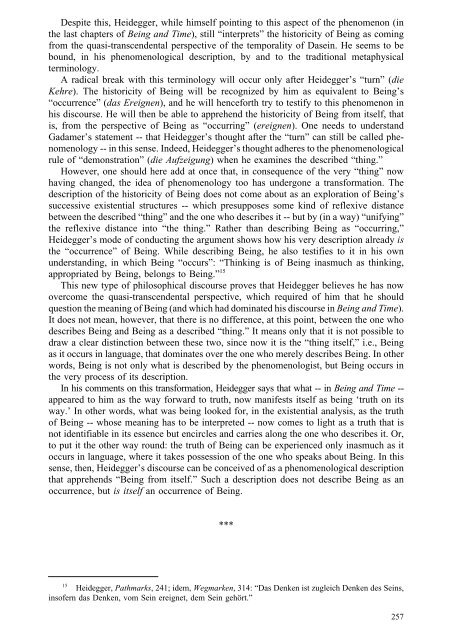[Andrzej_Wiercinski_(ed ... - WordPress.com
[Andrzej_Wiercinski_(ed ... - WordPress.com
[Andrzej_Wiercinski_(ed ... - WordPress.com
You also want an ePaper? Increase the reach of your titles
YUMPU automatically turns print PDFs into web optimized ePapers that Google loves.
Despite this, Heidegger, while himself pointing to this aspect of the phenomenon (inthe last chapters of Being and Time), still “interprets” the historicity of Being as <strong>com</strong>ingfrom the quasi-transcendental perspective of the temporality of Dasein. He seems to bebound, in his phenomenological description, by and to the traditional metaphysicalterminology.A radical break with this terminology will occur only after Heidegger’s “turn” (dieKehre). The historicity of Being will be recogniz<strong>ed</strong> by him as equivalent to Being’s“occurrence” (das Ereignen), and he will henceforth try to testify to this phenomenon inhis discourse. He will then be able to apprehend the historicity of Being from itself, thatis, from the perspective of Being as “occurring” (ereignen). One ne<strong>ed</strong>s to understandGadamer’s statement -- that Heidegger’s thought after the “turn” can still be call<strong>ed</strong> phenomenology-- in this sense. Inde<strong>ed</strong>, Heidegger’s thought adheres to the phenomenologicalrule of “demonstration” (die Aufzeigung) when he examines the describ<strong>ed</strong> “thing.”However, one should here add at once that, in consequence of the very “thing” nowhaving chang<strong>ed</strong>, the idea of phenomenology too has undergone a transformation. Th<strong>ed</strong>escription of the historicity of Being does not <strong>com</strong>e about as an exploration of Being’ssuccessive existential structures -- which presupposes some kind of reflexive distancebetween the describ<strong>ed</strong> “thing” and the one who describes it -- but by (in a way) “unifying”the reflexive distance into “the thing.” Rather than describing Being as “occurring,”Heidegger’s mode of conducting the argument shows how his very description already isthe “occurrence” of Being. While describing Being, he also testifies to it in his ownunderstanding, in which Being “occurs”: “Thinking is of Being inasmuch as thinking,appropriat<strong>ed</strong> by Being, belongs to Being.” 15This new type of philosophical discourse proves that Heidegger believes he has nowover<strong>com</strong>e the quasi-transcendental perspective, which requir<strong>ed</strong> of him that he shouldquestion the meaning of Being (and which had dominat<strong>ed</strong> his discourse in Being and Time).It does not mean, however, that there is no difference, at this point, between the one whodescribes Being and Being as a describ<strong>ed</strong> “thing.” It means only that it is not possible todraw a clear distinction between these two, since now it is the “thing itself,” i.e., Beingas it occurs in language, that dominates over the one who merely describes Being. In otherwords, Being is not only what is describ<strong>ed</strong> by the phenomenologist, but Being occurs inthe very process of its description.In his <strong>com</strong>ments on this transformation, Heidegger says that what -- in Being and Time --appear<strong>ed</strong> to him as the way forward to truth, now manifests itself as being ‘truth on itsway.’ In other words, what was being look<strong>ed</strong> for, in the existential analysis, as the truthof Being -- whose meaning has to be interpret<strong>ed</strong> -- now <strong>com</strong>es to light as a truth that isnot identifiable in its essence but encircles and carries along the one who describes it. Or,to put it the other way round: the truth of Being can be experienc<strong>ed</strong> only inasmuch as itoccurs in language, where it takes possession of the one who speaks about Being. In thissense, then, Heidegger’s discourse can be conceiv<strong>ed</strong> of as a phenomenological descriptionthat apprehends “Being from itself.” Such a description does not describe Being as anoccurrence, but is itself an occurrence of Being.***15Heidegger, Pathmarks, 241; idem, Wegmarken, 314: “Das Denken ist zugleich Denken des Seins,insofern das Denken, vom Sein ereignet, dem Sein gehört.”257


